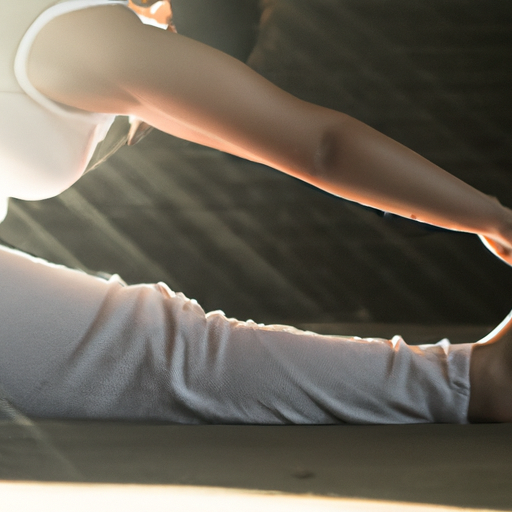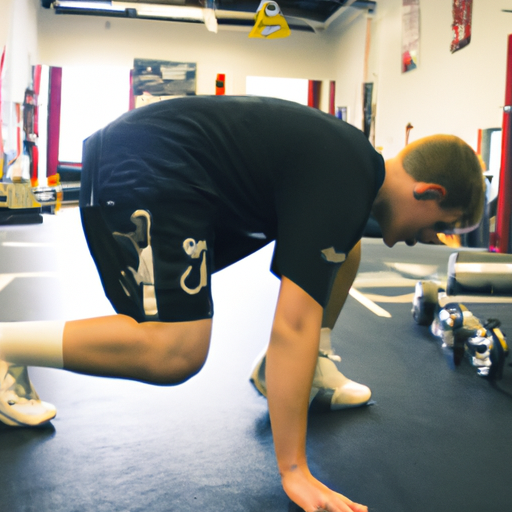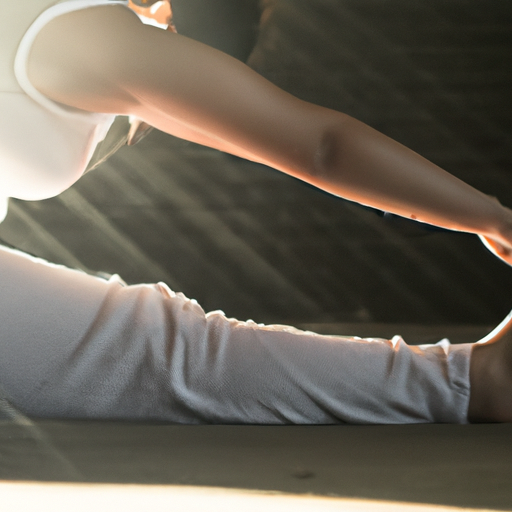
In today’s fast-paced and sedentary lifestyle, incorporating stretching into your daily routine is of utmost importance. In “Why Stretching is Vital: A Comprehensive Guide for Beginners,” you will find a wealth of information on the benefits and importance of stretching, specifically designed to cater to beginners.
This comprehensive guide provides a detailed overview of the various benefits of stretching, ranging from improved flexibility and muscle performance to enhanced blood circulation and reduced risk of injuries. You will also learn about the different types of stretching exercises, such as static and dynamic stretching, and how to properly perform them. Additionally, this guide emphasizes the significance of including stretching exercises before and after physical activities to maximize their effectiveness.
Whether you are a fitness enthusiast looking to enhance your workout routine or someone simply seeking to improve their overall well-being and flexibility, “Why Stretching is Vital: A Comprehensive Guide for Beginners” is an invaluable resource. By incorporating stretching into your daily life, you can unlock a multitude of benefits that will contribute to your overall health and longevity.

More Information Here on Weight Loss
Why Is Stretching Important?
Stretching is an essential component of any well-rounded fitness routine. It plays a crucial role in maintaining flexibility, preventing injuries, and improving overall physical performance. Incorporating stretching exercises into your daily routine can yield numerous benefits that will enhance your overall well-being. In this comprehensive guide, we will explore the importance of stretching, different types of stretching, stretching techniques, stretching routines, tips for safe stretching, common stretching mistakes to avoid, recommended stretching equipment, and how to incorporate stretching into your fitness regimen.
Benefits of Stretching
Stretching offers a myriad of benefits for both your body and mind. Here are some key advantages of incorporating stretching into your daily routine:
- Improved Flexibility: Stretching helps to increase the flexibility of your muscles and joints, allowing for a greater range of motion. This increased flexibility can enhance your performance in various physical activities, such as sports and daily tasks.
- Injury Prevention: Regular stretching can help prevent injuries by improving muscle flexibility and joint mobility. It reduces muscle imbalances and improves muscle coordination, making you less prone to strains, sprains, and other common injuries.
- Muscle Recovery: Stretching can aid in muscle recovery after intense workouts by reducing muscle soreness and promoting the removal of lactic acid build-up. It also helps increase blood flow to the muscles, aiding in their repair and rejuvenation.
- Stress Relief: Stretching promotes relaxation and helps relieve stress. It encourages deep breathing and improves blood circulation, which in turn reduces tension and promotes a sense of calmness.
- Improved Posture: Regular stretching can help correct poor posture by lengthening tight muscles that contribute to imbalances. By improving your posture, you can alleviate back, neck, and shoulder pain, and enhance your overall appearance.
How Stretching Improves Flexibility
Flexibility refers to the ability of your muscles and joints to move through their full range of motion. By regularly stretching your muscles, you can gradually increase their elasticity, allowing them to lengthen and become more flexible. This increased flexibility not only enhances your physical performance but also reduces the risk of muscle strains and other injuries.
When you stretch, your muscles and tendons are gently elongated, leading to the remodeling of the connective tissue within them. This remodeling process encourages improved tissue alignment, resulting in a better overall function of the muscles and joints. Additionally, stretching helps to increase the synovial fluid within your joints, which lubricates them and allows for smoother movement.
Stretching for Injury Prevention
One of the primary benefits of stretching is injury prevention. By regularly engaging in stretching exercises, you can reduce the risk of muscle strains, sprains, and other common injuries. Here’s how stretching contributes to injury prevention:
- Improved Muscle Flexibility: When your muscles are more flexible, they are less likely to be strained or torn during physical activities. Stretching helps to maintain muscle flexibility, reducing the risk of muscle imbalances that can lead to injuries.
- Increased Joint Range of Motion: Stretching improves joint flexibility and mobility, allowing for a greater range of motion. This increased range of motion helps to prevent joint-related injuries, as your joints are better prepared to handle different movements and stresses.
- Enhanced Muscle Coordination: Regular stretching improves muscle coordination and balance, reducing the risk of falls and other accidents. When your muscles are properly aligned and functioning together, you are less likely to experience sudden jerks, twists, or missteps that could result in injury.
- Decreased Muscle Tension: Stretching helps to alleviate muscle tension and tightness, which can lead to decreased flexibility and increased risk of injury. Relaxed muscles are less likely to become strained or overloaded during physical activities.
By incorporating stretching exercises into your fitness routine, you can significantly reduce the risk of injuries and ensure that your body is adequately prepared for physical activities.
Different Types of Stretching
Stretching exercises can be categorized into different types, each with its own benefits and purposes. Understanding these different types of stretching can help you choose the most suitable approach based on your specific goals and needs. The four main types of stretching are:
Static Stretching
Static stretching is a common type of stretching where a muscle or group of muscles is stretched to its furthest point and held in that position for a prolonged period, usually between 15 to 60 seconds. This form of stretching helps to increase the length of the muscle and improve flexibility over time. Static stretching is typically done after a workout or physical activity when the muscles are warm.
Dynamic Stretching
Dynamic stretching involves movement through a full range of motion to warm up the muscles and increase joint mobility. Unlike static stretching, which involves holding a stretch, dynamic stretching includes continuous movement. It is commonly used as a warm-up before physical activities to prepare the body for movement, improve circulation, and enhance performance.
PNF Stretching
PNF (Proprioceptive Neuromuscular Facilitation) stretching is a stretching technique that combines passive stretching and isometric contractions. It involves contracting and relaxing the targeted muscles to improve flexibility. PNF stretching is often performed with a partner or a qualified professional who assists in applying resistance during the contractions.
Active Isolated Stretching
Active Isolated Stretching (AIS) focuses on isolated muscle groups and involves actively contracting the opposing muscles while stretching the target muscle. This stretching technique is performed in a repetitive and controlled manner to increase flexibility and range of motion. AIS is commonly used by athletes and physical therapists for rehabilitation and injury prevention.
By understanding the different types of stretching, you can tailor your stretching routine to suit your specific goals, whether it be improving flexibility, preparing for physical activities, or aiding in injury prevention.

More Information Here on Weight Loss
Stretching Techniques
Stretching can target specific areas of your body and address different muscle groups. Here are some common stretching techniques for key areas:
Neck Stretches
Neck stretches can help relieve tension and stiffness in the neck and shoulder area. Simple stretches such as neck tilts, neck rotations, and neck side bends can be performed by gently moving your head in different directions and holding the stretch for a few seconds.
Shoulder Stretches
Shoulder stretches can help improve shoulder mobility and flexibility. Arm circles, shoulder rolls, and cross-body arm stretches are effective techniques for stretching the shoulders. These stretches involve moving your arms and shoulders in different directions to loosen up the muscles and improve range of motion.
Chest Stretches
Chest stretches can help counteract the effects of poor posture and tight chest muscles. Common chest stretches include doorway stretches, wall stretches, and chest expansions. These stretches involve opening up the chest area by extending your arms and gently pushing or pulling against a stable surface.
Back Stretches
Back stretches are essential for maintaining a healthy spine, relieving back pain, and improving posture. Techniques such as cat-cow stretch, child’s pose, and seated spinal twist can help stretch and release tension in the back muscles. These stretches involve gentle movements and poses that promote flexibility and alleviate back discomfort.
Leg Stretches
Leg stretches are crucial for maintaining flexibility, preventing muscle imbalances, and improving lower body performance. Common leg stretches include standing quadriceps stretch, seated hamstring stretch, and standing calf stretch. These stretches target the major muscle groups in the legs and can be performed in various positions to target different areas.
By incorporating these stretching techniques into your routine, you can effectively stretch and improve the flexibility of specific areas of your body.
Stretching Routines
Having a structured stretching routine can help you be consistent and ensure that you are targeting all the major muscle groups in your body. Here are a few sample stretching routines to consider:
Full Body Stretching Routine
A full-body stretching routine involves stretching all major muscle groups in your body. This routine can be done at the start or end of a workout, or as a standalone stretching session. It typically includes stretches for the neck, shoulders, chest, back, arms, legs, and core.
Morning Stretching Routine
A morning stretching routine is a great way to awaken your body and prepare it for the day ahead. This routine can include gentle stretches for the neck, shoulders, back, and legs. It helps to increase blood flow, reduce muscle stiffness, and improve overall energy levels.
Pre-Workout Stretching Routine
A pre-workout stretching routine focuses on preparing your muscles and joints for physical activity. It should include dynamic stretches that mimic the movements you will be performing during your workout. This routine helps to warm up the muscles, increase circulation, and enhance performance.
Post-Workout Stretching Routine
A post-workout stretching routine aims to cool down your body and aid in muscle recovery. It typically includes a combination of static and dynamic stretches to release tension, reduce muscle soreness, and improve flexibility. Stretching after a workout can help prevent muscle tightness and promote relaxation.
By following a stretching routine that aligns with your goals and lifestyle, you can ensure that you are reaping the maximum benefits of stretching while remaining consistent in your practice.
Tips for Safe Stretching
While stretching is generally safe and beneficial, it is important to approach it with caution and adhere to safe stretching practices. Here are some tips to ensure safe stretching:
Warm Up Before Stretching
Prior to engaging in any stretching activities, it is important to warm up your muscles to increase blood flow and prepare them for stretching. A warm-up can include light aerobic exercises such as brisk walking or jogging, cycling, or jumping jacks.
Avoid Overstretching
It is crucial to avoid pushing your body beyond its limits during stretching. Overstretching can lead to muscle strains, tears, or other injuries. Instead, focus on stretching until you feel a gentle pull or tension in the targeted muscle, without any sharp pain.
Breathe and Relax
During stretching, remember to breathe deeply and relax your muscles. Proper breathing helps to oxygenate your muscles and promotes relaxation, allowing for a deeper stretch. Avoid holding your breath, as it can lead to muscle tension and limit the effectiveness of the stretch.
Start Slowly and Progress Gradually
If you are new to stretching, start with gentle stretches and gradually increase the intensity and duration of each stretch over time. Pushing yourself too hard or attempting advanced stretches before your body is ready can result in injury. Listen to your body and respect its limits.
By incorporating these safe stretching practices into your routine, you can minimize the risk of injury and maximize the benefits of stretching.
Common Stretching Mistakes to Avoid
To ensure optimal results from your stretching routine, it is important to avoid common mistakes that can undermine its effectiveness and potentially lead to injury. Here are some common stretching mistakes to avoid:
Holding Your Breath
Many people tend to hold their breath while stretching, depriving their muscles of adequate oxygen and reducing the effectiveness of the stretch. Remember to breathe deeply and exhale slowly during each stretch to enhance relaxation and oxygenation of the muscles.
Bouncing or Ballistic Stretching
Bouncing or performing rapid movements while stretching can cause muscle tears or strains. Avoid bouncing or using momentum to stretch your muscles. Instead, perform each stretch in a controlled and smooth manner, holding the stretch without any jerky movements.
Stretching Cold Muscles
Stretching cold muscles can increase the risk of injury. Make sure to warm up your muscles before stretching, either through light aerobic activities or a warm shower. Warm muscles are more pliable and less prone to injuries during stretching.
Forgetting to Stretch Both Sides
It is essential to stretch both sides of your body evenly to maintain balance and prevent muscle imbalances. Neglecting to stretch both sides of your body can lead to asymmetrical muscle development and potential musculoskeletal issues. Be mindful of stretching each side equally.
By being aware of these common stretching mistakes and taking steps to avoid them, you can ensure that your stretching routine is safe, effective, and conducive to your overall fitness goals.
Stretching Equipment
While stretching can be done without any equipment, certain tools and accessories can enhance your stretching experience. Here are some commonly used stretching equipment:
Yoga Mat
A yoga mat provides a comfortable and stable surface for performing various floor-based stretching exercises. It offers cushioning and grip, preventing your hands or feet from slipping during stretches. Yoga mats are widely available and come in different materials, thicknesses, and sizes.
Foam Roller
A foam roller is a cylindrical tool made of dense foam that is used for self-myofascial release (SMR) and deep tissue massage. It can help alleviate muscle tightness and knots by applying pressure to specific areas of the body. Foam rollers are especially beneficial for targeting large muscle groups such as the legs, back, and hips.
Resistance Bands
Resistance bands are versatile tools that can be used for stretching and strengthening exercises. They provide resistance when stretched, allowing you to effectively engage and stretch different muscle groups. Resistance bands come in various resistance levels, offering a wide range of intensities for different fitness levels.
Stretching Strap
A stretching strap, also known as a yoga strap or a resistance band with loops, can assist in deepening stretches and improving flexibility. The loops on the strap allow for secure and comfortable gripping. Stretching straps are particularly useful for individuals with limited flexibility or those recovering from injuries.
These stretching tools can be valuable additions to your stretching routine, as they can help enhance your stretches, target specific muscle groups, and provide additional support when needed.
Incorporating Stretching Into Your Routine
To effectively incorporate stretching into your routine, it is important to find the right time, set realistic goals, and consider combining stretching with other exercises. Here are some tips to help you seamlessly integrate stretching into your fitness regimen:
Finding the Right Time
It is best to stretch when your muscles are warm and pliable. Consider incorporating stretching after a light warm-up or at the end of a workout session. Alternatively, you can dedicate a specific time of day, such as mornings or evenings, to perform your stretching routine.
Setting Realistic Goals
Set realistic goals for your stretching routine to ensure continued motivation and progress. Whether it’s improving flexibility, preventing muscle imbalances, or reducing muscle soreness, establish measurable and achievable objectives. Start with small milestones and gradually increase the intensity, duration, and difficulty of your stretches over time.
Combining Stretching with Other Exercises
Stretching can be combined with other forms of exercise, such as strength training, cardiovascular workouts, or yoga. By combining different types of exercises, you can create a well-rounded fitness routine that encompasses flexibility, strength, endurance, and balance. Consider alternating days or incorporating stretching exercises in between strength or cardio workouts.
By customizing your stretching routine to fit your schedule, setting realistic goals, and integrating it with other exercises, you can ensure that stretching becomes a regular and effective part of your fitness routine.
Frequently Asked Questions
Can Stretching Help with Muscle Soreness?
Stretching after a workout can help alleviate muscle soreness and promote recovery. It increases blood flow to the muscles and aids in the removal of lactic acid build-up. Additionally, stretching helps lengthen and relax the muscles, reducing post-workout muscle tightness and discomfort.
Can Stretching Help with Posture?
Yes, regular stretching can help improve posture. Stretching exercises target tight and overactive muscles that can contribute to poor posture. By stretching these muscles, such as the chest, hip flexors, and neck muscles, you can alleviate muscular imbalances and promote proper alignment of the spine and joints.
Should I Stretch Before or After Exercise?
It is generally recommended to perform a dynamic warm-up before exercise and to save static stretching for after your workout. A dynamic warm-up helps prepare your muscles and joints for physical activity, while static stretching afterward helps cool down the body and promote recovery.
How Long Should I Hold Each Stretch?
The recommended duration for holding a stretch is typically between 15 to 60 seconds. This duration allows enough time for the muscle to relax and lengthen. However, some individuals may benefit from shorter or longer hold times based on their flexibility level and comfort. Listen to your body, aim for a gentle pull or tension, and avoid any pain while stretching.
Conclusion
Stretching is far more than just a warm-up or cool-down routine; it is a vital aspect of overall health and physical well-being. By incorporating stretching into your daily routine, you can improve flexibility, prevent injuries, enhance muscle recovery, relieve stress, and achieve better overall performance. With the knowledge of different stretching types, techniques, routines, and safe stretching practices, you can unleash the full potential of stretching and enjoy the numerous benefits it offers. Start incorporating stretching into your fitness regimen today and experience the positive impact it can have on your body and mind.
